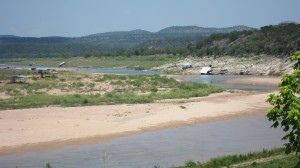In the midst of the 2013 Texas drought, many towns and communities have suffered disastrous blows, either completely running out of water or coming close enough to warrent desperate measures. Some of have made significant headlines, including Spicewood Beach, Barnhart and Brownwood.
According to TCEQ, 665 water systems have implemented mandatory restrictions. 10 have been placed in a state of emergency in the last year, which means they could run out of water within 45 days or less.
Spicewood Beach was the first Texas town to run out of water in early 2012, when low lake levels resulted in the well failure, and the community is still waiting for a solution. Since last year, the Lower Colorado River Authority (LCRA) has been trucking in about 32,500 gallons of water per day and an additional 6,500 gallons on weekends to serve the town’s more than 7,500 residents. The community is under stage 4 water restrictions, meaning residents cannot perform any outdoor watering; water is only for essential uses. The LCRA Board unanimously approved construction of a $1.2 million water treatment plant, which will be built by the Vancouver based private company Corix Utilities. The LCRA had hoped they could end stage 4 restrictions by completing the plant by the end of the summer, but Corix does not expect to finish construction until November. The company’s Texas-based operations manager Darrin Barker stated that obtaining permits from the necessary agencies like TCEQ, LCRA, and US Army Corp of Engineers will add up to three months to the process.
The West Texas community of Barnhart, about 50 miles west of San Angelo, suffered a disastrous fate on June 4 when they officially ran out of water. The town’s sole public well source stayed dry for nearly 3 days. Residents point to the local economy’s reliance on oil and gas drilling as a contributing factor to the problem. “This is Texas industry. This [oil and gas] is what makes Texas money, and yes, we have to have it, but not at this expense,” said Barnhart resident Glenda Kuykendall. On June 6, TCEQ released a statement, saying that “the water system issued a boil water notice as a precautionary measure due to the low water pressure.” However, as of June 18, the agency has only listed Barnhart in stage 3 and as an area of “concern,” meaning they could run out of water in 180 days or less. Barnhart has only 112 residents, which could mean that the potential well capacity exceeds the consumer demand, giving them a higher window of time before a potential outage threat after mitigating the problem.
Brownwood’s primary water source, Lake Brownwood, dropped 17 feet during the 2011 drought and came close to running out of water. The drought still lingers here, a major concern for Brown County Water Improvement District General Manager Dennis Spinks. The District hopes to drill and tap two aquifers 3,000 feet down, but if they fail, the backup plan is to turn treated sewage into drinking water, sending it directly back into the city pipes and eliminating the lake as the middle man. The city obtained a permit from TCEQ and funding from the Texas Water Development Board (TWDB) that would allow such a strategy. Brownwood has approximately 20,000 residents and is currently under stage 3 watering restrictions. However, the Water District board members have debated entering stage 4 and are closely monitoring lake levels to determine whether or not it will be necessary.



 It has been less than 24 hours since I received a copy of
It has been less than 24 hours since I received a copy of 



